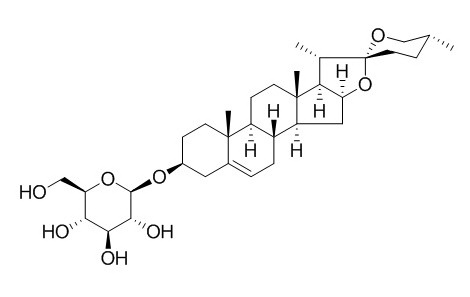Diosgenin glucoside
Diosgenin glucoside and other synthetic glycosides with similar activities may be of use in the management of hypercholesterolemia and atherosclerosis.
Inquire / Order:
manager@chemfaces.com
Technical Inquiries:
service@chemfaces.com
Tel:
+86-27-84237783
Fax:
+86-27-84254680
Address:
1 Building, No. 83, CheCheng Rd., Wuhan Economic and Technological Development Zone, Wuhan, Hubei 430056, PRC
Providing storage is as stated on the product vial and the vial is kept tightly sealed, the product can be stored for up to
24 months(2-8C).
Wherever possible, you should prepare and use solutions on the same day. However, if you need to make up stock solutions in advance, we recommend that you store the solution as aliquots in tightly sealed vials at -20C. Generally, these will be useable for up to two weeks. Before use, and prior to opening the vial we recommend that you allow your product to equilibrate to room temperature for at least 1 hour.
Need more advice on solubility, usage and handling? Please email to: service@chemfaces.com
The packaging of the product may have turned upside down during transportation, resulting in the natural compounds adhering to the neck or cap of the vial. take the vial out of its packaging and gently shake to let the compounds fall to the bottom of the vial. for liquid products, centrifuge at 200-500 RPM to gather the liquid at the bottom of the vial. try to avoid loss or contamination during handling.
Asian Journal of Chemistry2014, 26(8):2425
Food Chem X.2024, 24:101909.
Front Pharmacol.2021, 12:690113.
Metabolites.2023, 13(5):625.
Journal of Apiculture2019, 34(2):131-136
J Food Sci.2024, 3841.17112.
J Adv Res.2019, 17:85-94
Korean Journal of Pharmacognosy2014, 113-120
Int J Mol Sci.2022, 23(23):14545.
Kyung Hee University2024, rs-3888374
Related and Featured Products
J Lipid Res. 1987 Jan;28(1):1-9.
Effects of synthetic glycosides on steroid balance in Macaca fascicularis.[Pubmed:
3559397]
METHODS AND RESULTS:
The predominantly beta-anomer of Diosgenin glucoside (DG) was synthesized and its effects on cholesterol homeostasis were tested in monkeys. Cynomolgus macaques (Macaca fascicularis) were fed, during two 3-week periods, a semipurified diet with 0.1% cholesterol and a similar ration containing 1% Diosgenin glucoside, respectively. A Chow diet was given for 5 weeks between the experimental periods. Cholesterol and bile acid balance were analyzed during the last week of each semipurified diet. Diosgenin glucoside reduced cholesterolemia from 292 mg/dl to 172 mg/dl, decreased intestinal absorption of exogenous cholesterol from 62.4% to 26.0%, and increased secretion of endogenous cholesterol from -0.8 to 93.5 mg/day. The fecal excretion of neutral steroids rose from 40.7 to 157.3 mg/day; that of bile acids changed, nonsignificantly, from 23.1 to 16.0 mg/day. The cholesterol balance was -44 mg/day in the control period, and 88 mg/day in the DG-fed animals. No toxic signs were observed.
CONCLUSIONS:
Thus, when long-term studies demonstrate that the glucoside is well tolerated, Diosgenin glucoside and other synthetic glycosides with similar activities may be of use in the management of hypercholesterolemia and atherosclerosis.
Phytochemistry. 2001 Nov;58(5):663-9.
Phospholipids modulate the substrate specificity of soluble UDP-glucose:steroid glucosyltransferase from eggplant leaves.[Pubmed:
11672729]
METHODS AND RESULTS:
UDP-glucose-dependent glucosylation of solasodine and diosgenin by a soluble, partially purified enzyme fraction from eggplant leaves is affected in a markedly different way by some phospholipids. While glucosylation of diosgenin and some closely related spirostanols, e.g. tigogenin or yamogenin, is strongly inhibited by relatively low concentrations of several phospholipids, the glucosylation of solasodine is unaffected or even slightly stimulated. These effects depend both on the structure of the polar head group and the nature of the acyl chains present in the phospholipid. The most potent inhibitors of diosgenin glucosylation are choline-containing lipids: phosphatidylcholine (PC) and sphingomyelin (SM) but the removal of phosphocholine moiety from these phospholipids by treatment with phospholipase C results in an almost complete recovery of the Diosgenin glucoside formation by the enzyme. Significant inhibition of Diosgenin glucoside synthesis and stimulation of solasodine glucosylation was found only with PC molecular species containing fatty acids with chain length of 12-18 carbon atoms. PC with shorter or longer acyl chains had little effect on glucosylation of either diosgenin or solasodine.
CONCLUSIONS:
Our results indicate that interaction between the investigated glucosyltransferase and lipids are quite specific and suggest that modulation of the enzyme activity by the nature of the lipid environment may be of importance for regulation of in vivo synthesis of steroidal saponins and glycoalkaloids in eggplant.



